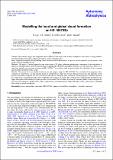Files in this item
Modelling the local and global cloud formation on HD 189733b
Item metadata
| dc.contributor.author | Lee, Graham Kim Huat | |
| dc.contributor.author | Helling, Christiane | |
| dc.contributor.author | Dobbs-Dixon, I. | |
| dc.contributor.author | Juncher, D. | |
| dc.date.accessioned | 2015-08-12T12:10:06Z | |
| dc.date.available | 2015-08-12T12:10:06Z | |
| dc.date.issued | 2015-08 | |
| dc.identifier | 209175111 | |
| dc.identifier | a969aad1-494e-4d7f-b8a9-18353d61e429 | |
| dc.identifier | 84937419559 | |
| dc.identifier | 000360020200012 | |
| dc.identifier.citation | Lee , G K H , Helling , C , Dobbs-Dixon , I & Juncher , D 2015 , ' Modelling the local and global cloud formation on HD 189733b ' , Astronomy & Astrophysics , vol. 580 , A12 . https://doi.org/10.1051/0004-6361/201525982 | en |
| dc.identifier.issn | 0004-6361 | |
| dc.identifier.uri | https://hdl.handle.net/10023/7194 | |
| dc.description | G.L. and Ch.H. highlight the financial support of the European community under the FP7 ERC starting grant 257431. | en |
| dc.description.abstract | Context. Observations suggest that exoplanets such as HD 189733b form clouds in their atmospheres which have a strong feedback onto their thermodynamical and chemical structure, and overall appearance. Aims. Inspired by mineral cloud modelling efforts for brown dwarf atmospheres, we present the first spatially varying kinetic cloud model structures for HD 189733b. Methods. We apply a 2-model approach using results from a 3D global radiation-hydrodynamic simulation of the atmosphere as input for a detailed, kinetic cloud formation model. Sampling the 3D global atmosphere structure with 1D trajectories allows us to model the spatially varying cloud structure on HD 189733b. The resulting cloud properties enable the calculation of the scattering and absorption properties of the clouds. Results. We present local and global cloud structure and property maps for HD 189733b. The calculated cloud properties show variations in composition, size and number density of cloud particles which are strongest between the dayside and nightside. Cloud particles are mainly composed of a mix of materials with silicates being the main component. Cloud properties, and hence the local gas composition, change dramatically where temperature inversions occur locally. The cloud opacity is dominated by absorption in the upper atmosphere and scattering at higher pressures in the model. The calculated 8 μm single scattering albedo of the cloud particles are consistent with Spitzer bright regions. The cloud particles scattering properties suggest that they would sparkle/reflect a midnight blue colour at optical wavelengths. | |
| dc.format.extent | 22 | |
| dc.format.extent | 20218975 | |
| dc.language.iso | eng | |
| dc.relation.ispartof | Astronomy & Astrophysics | en |
| dc.subject | Planets and satellites: individual: HD 189733b | en |
| dc.subject | Planets and satellites: atmospheres | en |
| dc.subject | Methods: numerical | en |
| dc.subject | QC Physics | en |
| dc.subject | NDAS | en |
| dc.subject.lcc | QC | en |
| dc.title | Modelling the local and global cloud formation on HD 189733b | en |
| dc.type | Journal article | en |
| dc.contributor.sponsor | European Research Council | en |
| dc.contributor.institution | University of St Andrews. School of Physics and Astronomy | en |
| dc.identifier.doi | 10.1051/0004-6361/201525982 | |
| dc.description.status | Peer reviewed | en |
| dc.identifier.grantnumber | 257431 257431 | en |
This item appears in the following Collection(s)
Items in the St Andrews Research Repository are protected by copyright, with all rights reserved, unless otherwise indicated.

